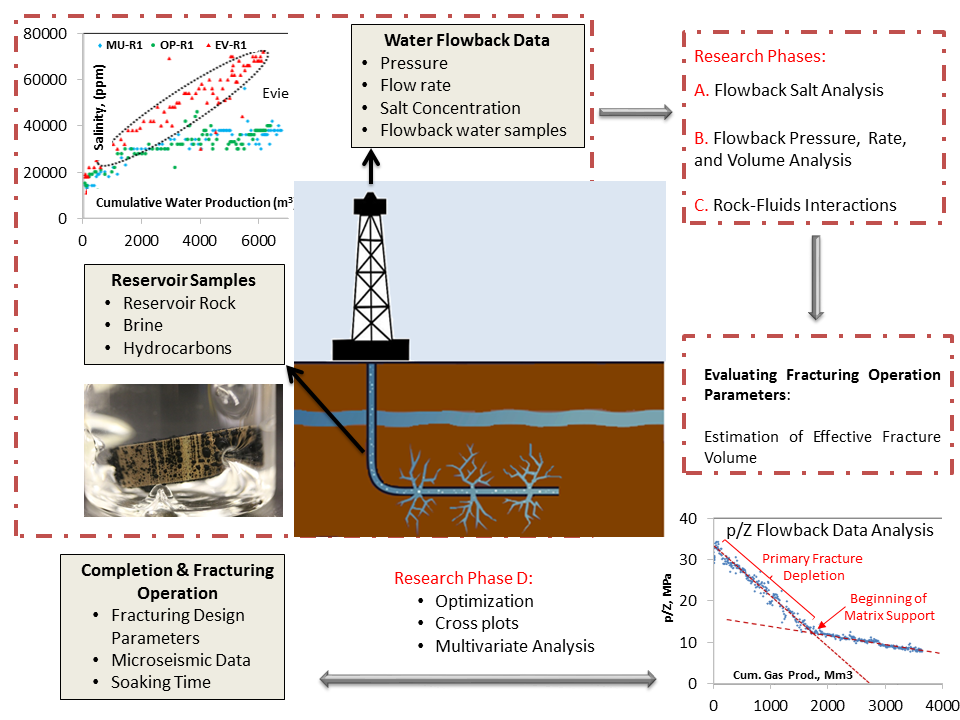Understanding the Fate of Non-recovered Fracturing Water and the Source of Produced Salts for Optimizing Fracking Operations
Lead Proponent: The University of Alberta
Location: Edmonton, Alberta
ecoEII Contribution: $ 450,000
Project Total: $ 770,000
Project Background
Decline of Canada’s conventional oil and gas resources has shifted the industry’s focus towards developing unconventional resources such as shale gas and tight oil. Hydrocarbon production from unconventional resources has significantly expanded due to the advent of hydraulic fracturing technologies. The hydraulic fracturing process involves the high-pressure injection of fracturing fluid (primarily water and sand or other proppants) into a wellbore to create cracks in the deep-rock formations through which oil and gas flows more freely. Produced saline (flowback) water is returned to the surface after hydraulic fracturing. However, field observations show that as little as 10% of the injected fracturing fluid may be recovered during flowback. Imbibition (or leak-off) of fracturing water into the rock matrix may be the main mechanism by which fracturing water is lost. Water imbibition in unconventional tight rocks is controlled not only by capillarity (as in conventional reservoir rocks) but also by clay chemistry, cation exchange capacity, osmotic potential and adsorption effects. Moreover, since the pores in tight rocks are extremely small, other surface phenomena such as van der Waals attraction and double layer repulsion may also play an important role. High salinity of flowback water may be attributed to mechanisms such as the mixing of fracturing water with formation water, diffusion of salts from pore water into fracturing water, dissolution of rock minerals in water and in-situ reactions such as oxidation of rock minerals. Lastly, little is known of the fate of non-produced fracturing water, and a better understanding of water-rock interactions and the characteristics of the fracture network is required. Recognizing the importance of addressing the knowledge gaps to optimize fracturing operations while mitigating environmental impacts, the University of Alberta proposed the project “Understanding the Fate of Non-recovered Fracturing Water and the Source of Produced Salts for Optimizing Fracking Operations". The project was awarded $450K from ecoEII.
Results

Caption: Workflow summarizing the research steps conducted in order to evaluate fracturing operations
Text Description:
This workflow summarizes the research steps conducted to evaluate the fracturing operations by analyzing laboratory and field data. Flowback water and core samples were analyzed in the laboratory to determine the source of flowback salts. The flowback data were analyzed to estimate the effective fracture volume. Analysis of the field data led to useful correlations between the estimated fracture volume and the design parameters for hydraulic fracturing operations.
The key unconventional shale gas and tight oil resources in Canada are the Horn River, Montney, and Duvernay plays. Hydraulic fracturing and flowback data, and rock samples from several multi-fractured horizontal wells in these three plays were analyzed to determine water flowback efficiency, effective fracture volume, and the type and concentration of produced salts. A better understanding of the source of produced flowback salts led to the development of a comprehensive workflow for fracture characterization through concentration transient analysis of flowback salts.
Laboratory tests were conducted to measure water imbibition and salt diffusion in three sets of cores from the wells drilled in the three plays. The samples were characterized by measuring petrophysical properties such as mineralogy, pore size distribution, porosity, and permeability. The type, concentration, and diffusion coefficient of different salt components existing in the core samples were also measured. Field data were analyzed to investigate the correlations among rock petrophysical properties, fracturing parameters, fracture network, and the efficiency of water recovery.
In combination, the field data and laboratory results revealed the source of flowback salts and the extent of water loss into the rock matrix after hydraulic fracturing operations. It was determined that up to 30% of water injected during hydraulic fracturing can be recovered to the surface after flowback operations. The remaining water appears to be trapped in the rock matrix and complex fracture network. Effective fracture volume was derived from upscaling of laboratory and field data. The results show that the effective fracture volume is significantly smaller than the total created fracture volume. It is concluded that part of the non-recovered water is trapped in the ineffective fractures which are poorly connected to the wellbore due to fracture closure phenomenon. Analysis of the field data led to useful correlations between the estimated fracture volume for different lateral wells and fracturing parameters.
Benefits to Canada
Knowledge of rock-fluid interactions will help Canadian operators improve produced water management. The new workflow for fracture characterization through concentration transient analysis of flowback salts may be applied by the industry to evaluate the fracturing operations, and to optimize future operations by reducing fresh water consumption.
Next Steps
Develop a data-driven multivariate algorithm that would estimate the volume of effective and ineffective fractures and help to determine the efficiency of hydraulic fracturing operations. Conduct the laboratory tests under high pressure/ temperature conditions.
Page details
- Date modified: